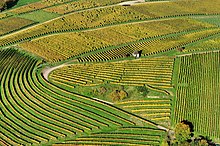Markgräflerland

Markgräflerland (German: [ˈmaʁkɡʁɛːflɐˌlant]) is a region in the southwest of Germany, in the south of the German federal state of Baden-Württemberg, located between the Breisgau in the north and the Black Forest in the east; adjacent to west with France and in the south with Switzerland.
History and geography

The name translates to Margraves' Land, in reference to the
The river
Viticulture

The region is known for its vineyards. A unique grape variety is the Gutedel grape, also known as
The region is often called by Germans the Tuscany of Germany, referring to the Tuscan region of Italy, due in part to its climate, milder than the rest of the nation.
Language
This region is home to the German dialect known as Alemannisch. The most famous writer of Alemannisch literature is Johann Peter Hebel.
Cities and towns

Markgräflerland includes (among others) the following locations:
External links
- Map: https://web.archive.org/web/20051222203414/http://www.geschichtsverein-markgraeflerland.de/
- Markgräflerland: pictures & history
